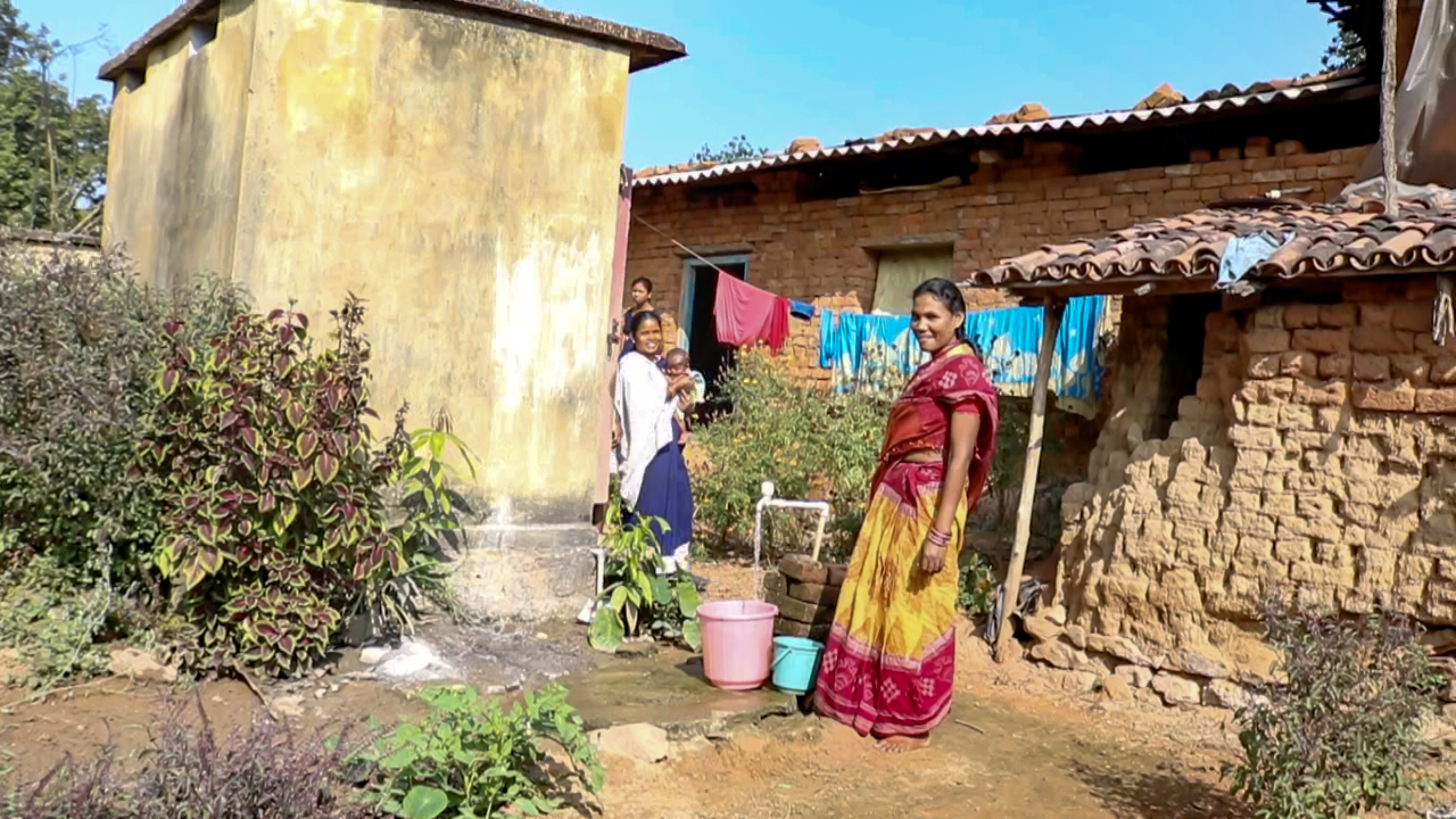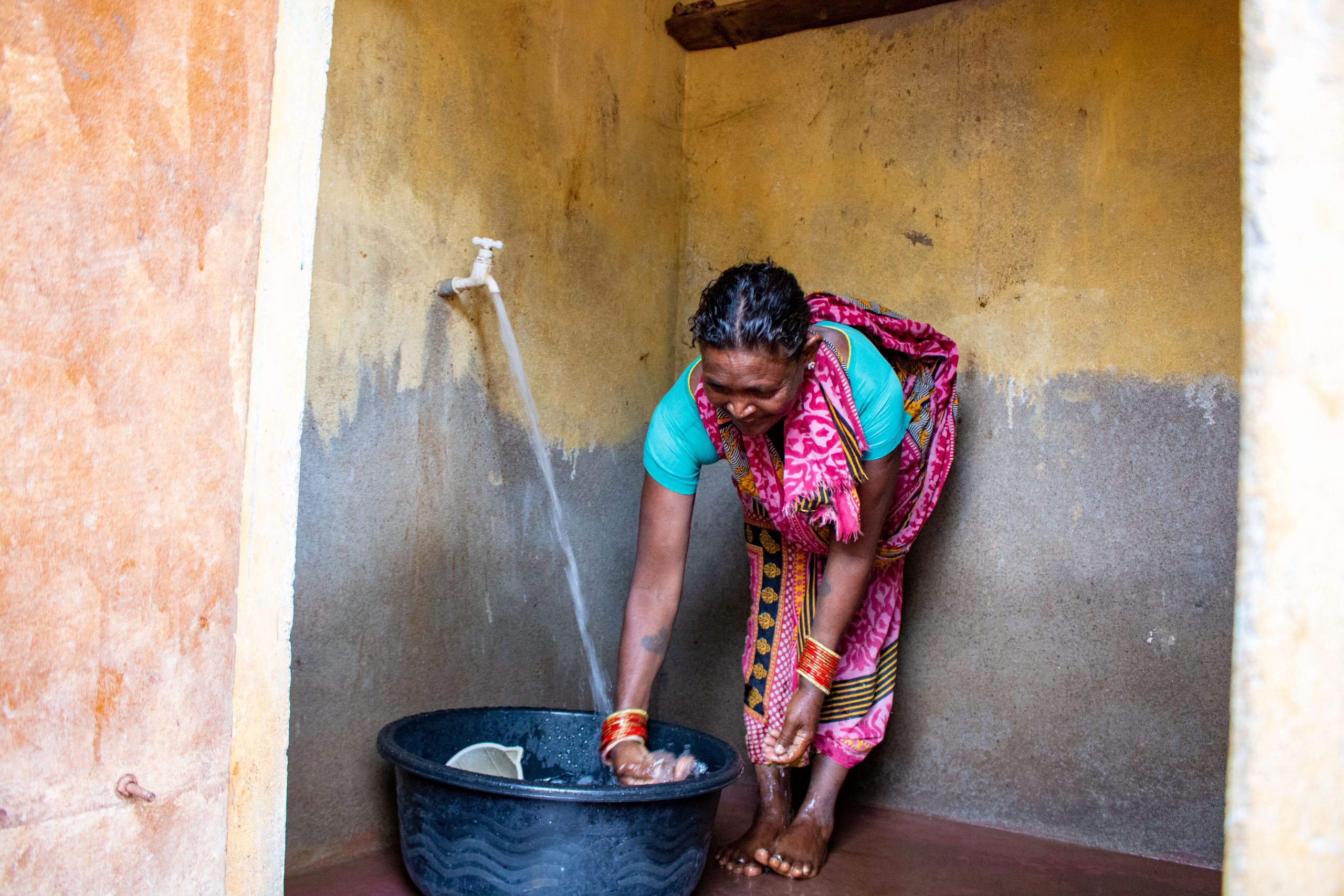Community ownership in the rural drinking water sector
FeatureBy Liby Johnson
26 February 2021

A woman fetching water from the third tap in the house premises. Photograph by Ajaya Kumar Behera
Jal Jeevan Mission has taken up the ambitious target to cover every rural household in India with a functional tap connection. It envisages achieving this as a people’s movement, where the drinking water supply is owned and managed by people and their representative institutions. Once achieved, this will go down as among the most audacious ways of achieving the principles of decentralisation of finances and functions and of strengthening local governance institutions to respond to the demands of their citizens in an effective manner.
There are many experiences, of community participation and management, in the rural drinking water sector from which one can glean lessons. Gram Vikas, a non-government organisation in Odisha, has been promoting a community-owned and managed integrated water and sanitation intervention in the villages of Odisha since 1995. More than 1400 village communities, covering about 82,000 households, have benefitted from these interventions in partnership with the Government of Odisha and donor agencies.
Gram Vikas experience in building single village water supply systems
Gram Vikas’ experience indicates that it is possible to build single village water supply systems owned and managed by village communities even in the most remote areas.
We can build the required institutional and technical capabilities and motivate communities to pay towards a part of the capital costs as well as a substantial amount of the operations and maintenance costs. A recent survey that covered nearly 41,500 households in 626 villages, where Gram Vikas had supported building piped water supply systems, shows that 87% of the surveyed households reported a functional tap connection at their homes.
The intervention in these villages happened during the years between 1995 and 2018. Only 67% of the households surveyed were part of the intervention when we took up the intervention in their village. About 33% of the households came up after Gram Vikas had exited the villages, and the respective community institutions had taken up the management of the piped water supply system.

Round the clock water supply in households allows women and men use toilet and bathing room anytime. Photograph by Ajaya Kumar Behera.
Enablers for a successful community-managed piped water supply system
The following four principles are essential and necessary conditions for building a community-managed piped water supply system.
All households are included: It is necessary that the programme includes 100% of the households in a village at all stages. No household, irrespective of its social or economic condition should be left out. This is necessary not only from a sanitation point of view, but also to ensure that poor people and the socially excluded would not be left out. If not included from the beginning, poor people would likely find it difficult to join later, especially in the more sharply stratified villages. Besides serving equity, the all or none approach also creates a unique opportunity for the entire village to work together for a shared purpose.
Inclusive processes are essential: Ensuring participation of every section and taking affirmative steps to ensure that women and poor people are included in management. Besides empowering the marginalised people, even if in a limited way, such inclusive processes are essential to ensure that the facility would continue to be managed well and for the benefit of all.
Costs are shared by all: Everyone has to share the costs. Insisting on a significant contribution to the initial capital cost and that people bear the cost of running and maintaining the facility helps build people’s stakes. This inclusive stake building would ensure that people would continue to look after the facility, individually as well as by making demands on the community organisation.
Community ownership is built early: The insistence that people ‘take responsibility’ from an early stage to generate consensus, mobilize local contributions, manage construction and take charge of operations and maintenance is a sound way to ensure long term sustainability. It creates experience in the community of negotiating with each other and with outsiders and of working together.
These four principles taken on their own will not be successful. It has to be the combination of all of them – inclusion, participation, cost-sharing and taking responsibility – to build a sustainable and effective process right from the beginning.
Support principles with action
These fundamental principles need to be supplemented with key interventions.
Building management and leadership capabilities of the community institutions: Substantial efforts need to be put into training programmes for women and men focusing on administrative and management aspects and motivational elements for effective leadership. Exposure visits are a good way to build capacities. Men and women from the villages are trained in technical aspects of plumbing, pipeline repairs and maintenance of pumping systems. Much of these trainings can happen ‘on the job’ while the initial work is taken up in the village. Periodic refresher and practical training can help build capacities further.
Creating financial mechanisms for sustainability: Gram Vikas helped each village set up a corpus fund with contributions from every household. The fund, invested and managed by the village institution in the form of a bank fixed deposit serves as a ‘resource in perpetuity’. The interest income from the corpus fund is used for the extension of services to new households and meeting major maintenance needs of the infrastructure systems.
Maintenance fund for the systems: The maintenance fund is a recurring financial instrument that helps meet the costs of the operations and maintenance of the piped water supply system, such as electricity charges, wages of the technical personnel and regular repairs and maintenance.
Villages have devised multiple methods for raising the maintenance fund. All households pay a monthly fee fixed by respective village committees. In some villages, the community contributes a proportion of the gross product from the harvest (0.25%-0.50%) towards the maintenance fund. Many villages deposit income from common property resources, such as the village pond for pisciculture or common wasteland developed as wood lots or orchards, in the maintenance fund, thus ensuring sufficient funds to meet the expenses.
Jal Jeevan Mission’s goal of empowering village communities to achieve sustained and regular access to safe drinking water is definitely achievable.
Water connection at household level helps old age person use water for daily chores without difficulty. Photograph by Ajaya Kumar Behera.
ACKNOWLEDGEMENT
The article first appeared in the December 2020 Issue of Jal Jeevan Samvad featuring experiences from around India in ensuring functional household tap water supply to rural communities. Priya Pillai edited the feature for this blog.
ABOUT THE AUTHOR
Liby Johnson is the Executive Director of Gram Vikas. He represents Gram Vikas in Government of India’s 14 member task force to review the rural water supply sector and recommend ways to strengthen the implementation of Jal Jeevan Mission.
RELATED BLOGPOSTS
Rural Odisha farmers enter carbon credit market in grassroots climate push
Farmers in Odisha lead community-driven agro and social forestry, earning carbon credits while restoring degraded lands.
Stories travel through cinema to rural doorsteps in remote corners of Odisha
Cinema that stirred hearts, sparked hope, and found purpose and voice for environmental change.
Odisha villages voice 7,648 demands as local governance listens
Villages in Odisha lead community planning processes to track progress, revise priorities, and align local needs with Gram Panchayat action.